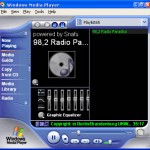Listening to momentary blips in music or a conversation is annoying, and the only way to compensate for that over an erratic network such as the Internet is to get some of the audio data into the computer before you start listening to it. In streaming audio, both the client and server cooperate for uninterrupted sound.
A one-way audio transmission over a data network. It is widely used to listen to audio clips and radio from the Internet on computers, tablets and smartphones. In addition, computers at home are commonly set up to stream a user’s music collection to a digital media hub connected to a stereo or home theater. See digital media hub.
Unlike music files that are downloaded and played at any time in the future, a streamed song is played immediately after a small amount of audio data is received, and the song file is not stored permanently in the destination device.
It’s Already in the Buffer
Listening to momentary blips in music or a conversation is annoying, and the only way to compensate for that over an erratic network such as the Internet is to get some of the audio data into the computer before you start listening to it. In streaming audio, both the client and server cooperate for uninterrupted sound. The client side stores a few seconds of sound in a buffer before it starts sending it to the speakers. Throughout the session, it continues to receive audio data ahead of time.
VoIP Is More Demanding
Voice over IP (VoIP) is more taxing on the network than streaming audio. It requires real-time, two-way transmission with sufficient bandwidth for audio coming in and going out at the same time without being able to buffer any of it.

